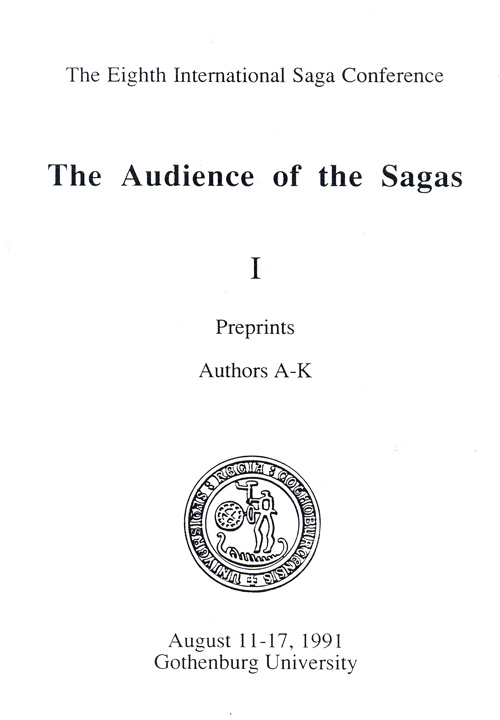The Audience of the Sagas: Preprints, I-II, ed. Lars Lönnroth (Gothenburg: Gothenburg University, 1991).
- Reidar Astås: Om Bibelanvendelsen i Þorláks saga.
- Karen Attar: Christianity and the sens of Tristrams saga.
- Sverre Bagge: Ideology and propaganda in Sverris saga.
- Régis Boyer: Vikings, sagas and Wasa bread.
- Giorgio Brugnoli: Le Traitement de Salluste par Adam de Breme.
- Peter Buchholz:
Vi bär alla samma sigill
: The revelance of Germanic and Scandinavian antiquity in a South African context.
- Jonas Carlquist: Öst- och västnordisk reception av helgonlegender: Likheter och skillnader.
- Margaret Clunies Ross and Judy Quinn: The image of Norse poetry in seventeenth-century England.
- Robert Cook: The effect of the conversion in Njáls saga.
- Margaret Cormack:
Fiǫlkunnigri kono scalattu í faðmi sofa
.
- Helle Degnbol: Ordbog over det norrøne prosasprog: Seneste udviklinger.
- Britta Olrik Frederiksen: Det første stemma, dets videnskabshistoriske baggrund og skaber(e).
- Jürg Glauser: Das Ende der Saga: Zum Verhältnis von Handschriftlicher und gedrucker Überlieferung der traditionellen Erzählliteratur im Island des 19. und Beginnen den 20. Jahrhunderts.
- Galina Glazyrina: Information about Eastern Europe in Old Norse sagas and its adaptation for the Nordic audience by saga-authors.
- Guðrún Nordal: Höfðingjaskáld á Sturlungaöld.
- Guðvarður Gunnlaugsson: Tekstkritiske problemer i Grettis saga.
- Elena A. Gurevich: Þulur in Skáldskaparmál: An attempt at skaldic lexicology.
- Natalia Ju. Gvozdetskaya: Old Icelandic names of emotions and the epic mind.
- Jan Ragnar Hagland: An 18th-century Norwegian reception of Old Nordic myths: Hans Jacob Wille’s Extract of Nordic mythology (1787).
- Peter Hallberg: An Icelandic saga of our time: Halldór Laxness’ Gerpla.
- Joseph Harris: The enigma og Gísla saga.
- Fredrik Heinemann: Intertextuality in Bjarnar saga Hítdælakappa.
- Anne Heinrichs: Der Kanon altnordischer Poesie im 18. Jahrhundert.
- Constance Hieatt: The Nordic background to Beowulf’s last words.
- Bengt Holmström: First boundary stone at Suntru Asi and Snutru Ase.
- Tatjana N. Jackson: The north of Eastern Europe in the ethnogeographical nomenclature of early Nordic texts.
- Judith Jesch: History in the
political sagas
.
- Jenny Jochens: Before the male gaze: The absence of the female body in Old Norse.
- Jón Hnefill Aðalsteinsson: Folklore in the Icelandic sagas and the blót of Guðrún Ósvífrsdóttir.
- Bengt R. Jonsson: With ballad poets in the audience: A special kind of reception.
- Marianne Kalinke: Osvalds saga konungs.
- John Kennedy: The English translations of Vǫlsunga saga.
- Jonna Kjær: Censure morale et transformations idéologiques dans deux traductions de Chrétien de Troyes: Ívens saga et Erex saga.
- Barbara Krebs and Rudolph Simek: The reception of natural science in 13th-century Iceland: A commentary on Gml. Kgl. Sml. 1812, 4to: A report on work in progress.
- Riti Kroesen: The gift of the supernatural giver in the heroic saga of the North.
- Hans Kuhn: The rímur poet and his audience.
- Carolyne Larrington:
What does woman want?
Mær and munr in Skírnismál.
- Anne Lidén: Sankt Olavsskåpet i Stralsund.
- John Lindow: Manumission ritual in Old West Scandinavian law.
- Flemming Lundgreen-Nielsen: Grundtvigs nordisk-mytologiske billedsprog — et mislykket eksperiment.
- Mats Malm: Improving history with Old Norse poetics: A 17th-century theory of interpretation.
- Edith Marold: Der Skalde und sein Publikum.
- John Stanley Martin: The transference of attitudes to Islam from France to Scandinavia in the Elie de Saint Gille and Elis saga ok Rósamundu.
- R. W. McTurk: The anxiety of influence and the Icelandic literary tradition.
- Elena Melnikova: Local lore and Latin science in Old Norse geography.
- Valeria Micillo: Classical tradition and Norse tradition in the Third Grammatical Treatise.
- Stephen A. Mitchell: Heroic legend, parricide and Istaby.
- Tomoaki Mizuno: Loki as a terrible stranger and a sacred visitor.
- Lotte Motz: The poets and the goddess.
- Elsa Mundal: Íslendingabók vurdert som bispestolskrønike.
- Gisela Nordstrandh:
Oc tw gør aff thenna huat tu gither
: En litterär-retorisk läsning av Erikskrönikans Joar Blå-episod.
- Richard North: How was Hávamál performed?
- Britt-Mari Näsström: Ottar and Angantyr in Hyndluljóð.
- Ólafía Einarsdóttir: Om Eiglas traditionsbærere og forfatter.
- Antonella Perelli: Olaus Magnus’ History and Torquato Tasso’s Torrismondo.
- Gryt Anne Piebenga: Om den svenske oversettelsen av Vita Mariae Oigniacensis.
- Diego Poli: Pastoral function at the Norwegian court.
- Fabrizio D. Raschellà: Glossography in medieval Scandinavia.
- Christopher Sanders: Grágás and orality: The oldest fragment.
- Carlo Santini: Leser, Zuhörer und Publikum in den Gesta Danorum von Saxo Grammaticus.
- Birgit Sawyer: The erection of rune-stones in Viking-age Scandinavia: The political background.
- Peter Sawyer: The background of Ynglingasaga.
- Riccardo Scarcia: La Tradition de la paradoxographie classique dans l’œuvre d’Olaus Magnus.
- Sigrún Davíðsdóttir: Håndskriftsagen: The case of the Icelandic manuscripts (abstract).
- Olga A. Smirnickaja: Grímnismál on the Eddic stage.
- Dariusz A. Sobczynski: Útlendingar á Íslandi: Vitnisburður Íslendinga sagna.
- Ulrike Sprenger: Die rhetorische Kunst von Grettir Ásmundarson.
- Fabio Stok: Die klassischen Vorbilder der Vita de Kanutus Lavard (Saxo Grammaticus, Gesta Danorum, Buch XIII).
- Ulrike Strerath-Bolz: Die Konzeption historischer Kontinuität im Prolog der Snorra Edda.
- John Tucker: Chapter divisions: The case of Gunnlaugs saga.
- Úlfar Bragason: Sturlunga: A political statement.
- Jens Ulff-Møller: The higher numerals in early Nordic texts, and the duodecimal system of calculation.
- Andrew Wawn: Choking on a morsal: Saga Játvarðar konungs hins helga and the nineteenth-century politics of saga.
- Diana Whaley: Nicknames and narratives in the sagas.
- I.M. Willert: The Danish version of the lengend og Roncevaux and its relationship with the Chanson de Roland.
- Kirsten Wolf: Om en
tabt
islandsk oversættelse af Evangelium Nicodemi.
- Lars Wollin: Literary reception or linguistic reproduction? On Johannes Bureus and the rise of Swedish medieval philology.
- Stefanie Würth: Die B-Version der Trójumannasaga: Stil und Intention der Bearbeitungen.

